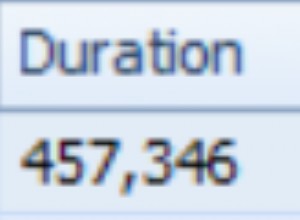Możesz zrobić coś takiego jak poniżej:
# table creation:
drop table if exists test_table;
create table test_table (your_date date, your_value int(11));
insert into test_table (your_date, your_value) values ('2020-01-01', 1);
insert into test_table (your_date, your_value) values ('2020-01-01', 2);
insert into test_table (your_date, your_value) values ('2020-01-03', 2);
insert into test_table (your_date, your_value) values ('2020-01-07', 3);
insert into test_table (your_date, your_value) values ('2020-01-08', 4);
insert into test_table (your_date, your_value) values ('2020-01-08', 1);
Tworzy to listę w zasadzie wszystkich dat. Następnie filtrujesz według dat, które Cię interesują, dołączasz do swojego stołu i grupy.
Możesz również zamienić daty w instrukcji WHERE na podzapytania (min. i maksymalna data tabeli), aby była dynamiczna
To trochę obejście, ale działa.
select sbqry.base_date, sum(ifnull(t.your_value, 0))
from (select adddate('1970-01-01',t4.i*10000 + t3.i*1000 + t2.i*100 + t1.i*10 + t0.i) base_date from
(select 0 i union select 1 union select 2 union select 3 union select 4 union select 5 union select 6 union select 7 union select 8 union select 9) t0,
(select 0 i union select 1 union select 2 union select 3 union select 4 union select 5 union select 6 union select 7 union select 8 union select 9) t1,
(select 0 i union select 1 union select 2 union select 3 union select 4 union select 5 union select 6 union select 7 union select 8 union select 9) t2,
(select 0 i union select 1 union select 2 union select 3 union select 4 union select 5 union select 6 union select 7 union select 8 union select 9) t3,
(select 0 i union select 1 union select 2 union select 3 union select 4 union select 5 union select 6 union select 7 union select 8 union select 9) t4) sbqry
left join test_table t on base_date = t.your_date
where sbqry.base_date between '2020-01-01' and '2020-01-08'
group by sbqry.base_date;
wejście:
+------------+------------+
| your_date | your_value |
+------------+------------+
| 2020-01-01 | 1 |
| 2020-01-01 | 2 |
| 2020-01-03 | 2 |
| 2020-01-07 | 3 |
| 2020-01-08 | 4 |
| 2020-01-08 | 1 |
+------------+------------+
wyjście:
+------------+------------------------------+
| base_date | sum(ifnull(t.your_value, 0)) |
+------------+------------------------------+
| 2020-01-01 | 3 |
| 2020-01-02 | 0 |
| 2020-01-03 | 2 |
| 2020-01-04 | 0 |
| 2020-01-05 | 0 |
| 2020-01-06 | 0 |
| 2020-01-07 | 3 |
| 2020-01-08 | 5 |
+------------+------------------------------+




